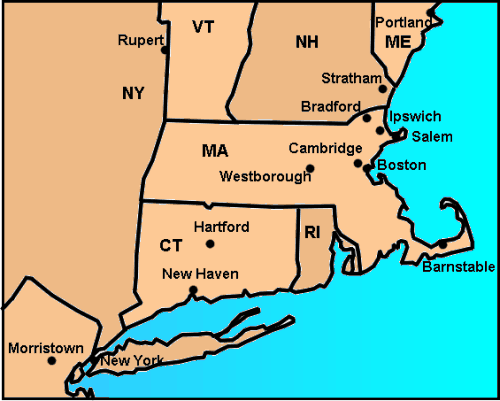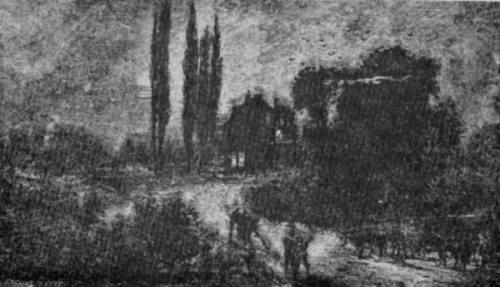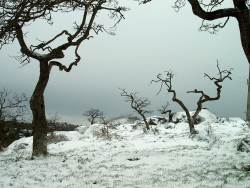 |
 |
| Home | Welcome | What's New | Site Map | Glossary | Weather Doctor Amazon Store | Book Store | Accolades | Email Us |
 | |||||||||
Weather Almanac for May 2004NEW ENGLAND'S DARK DAYThe abnormal darkening of daytime skies has often held fear and dread for humans and confusion among animals. There can be several causes for unexpected dark days: severe thunderstorms, solar eclipses, volcanic dust clouds and wildfire smoke and ash. Today, we are able to predict the exact moment of solar eclipses, and observation and communication networks keep us abreast of any severe storms, volcanic eruptions and wildfires. In 1780, however, this was not the case; information moved no faster than Paul Revere's ride. In May of that year, during a crucial time in the American Revolution, the skies over New England darkened, and no one knew why. Though daytime skies for several days had been unusually coloured — a dirty yellow tinge with a reddish-hued sun — no one in New England was fully prepared for the darkness that descended over the region on the morning of 19 May. When an early descending darkness took hold around the noon hour, all life reacted. Birds began singing their evening songs, then went silent and disappeared from view; frogs began to peep. Chickens returned to their roosts, and cattle walked slowly back to their barns, thinking evening had descended. Human outdoor travel became difficult. Professor Daggett of New Haven, Connecticut reported: "The greatest darkness at least equal to what was commonly called candle-lighting in the evening. The appearance was indeed uncommon, and the cause unknown." Opinions as to the cause of the darkness were mixed. Yale president Timothy Dwight observed: "It was the general opinion that the day of judgment was at hand." Many New Englanders abandoned their daily activities and congregated at hastily-convened religious services. Those with a more scientific viewpoint examined the sky and rain water that fell during the event to find a cause. In any case, the day would go down in history as "New England's Dark Day," "Black Friday" and even "The Wonderful Dark Day." The PreludeFrom the many diaries available from the period, David Ludlum was able to reconstruct a general synoptic picture of the event and surrounding days over the American Northeast ("New England's Dark Day: 19 May 1780" Weatherwise, June 1972). The following summarizes his research. For most of the preceding days of May, New England had been under the influence of cool temperatures and clear skies, indications of an anticyclonic influence with Canadian origins. Barometric records from Cambridge show high and steady pressure. In Salem, Massachusetts (records of Dr Edward Holyoke), the last rainfall had been observed on the 8th. Easterly winds on the 17th and 18th, indicate the high center now sat to the east. Several diaries reported a smoky aspect to the sky and a red hue to the sun for several hours after sunrise and before sunset. The morning of the 19th dawned cloudy and cool at Salem, early morning temperature at 43oF (6.1oF). The barometer was falling and continued to do so until after 10 AM at Bradford MA. A southwest wind was blowing, indicating that eastern Massachusetts was in the warm sector of a low pressure-trough frontal system. Across portions of eastern New England, showers and thundershowers fell before noon. Clouds would prevail across the region for much of the day, giving a darkness to the day in general, but how much was water cloud and how much was something else — likely smoke particles as we shall see — we cannot fully determine. The EventAs the extraordinary darkness descended, those observing it wondered if it was a local phenomenon or more widespread. With no rapid communication networks in place, the only way to determine the extent of the darkening was through letters and newspapers from across the region. After the event, Professor Samuel Williams of Harvard College undertook the collection of such information from across the region. He was able to determine that notice of the darkness was taken as far south as northern New Jersey and New York City coastal waters, as far north as Portland, Maine and west into the Hudson Valley, but no mention came from Philadelphia or outlying Pennsylvania. (The New Jersey report came from George Washington's diary at Morristown.) Williams concluded the dark centre of the event was located around northeastern Massachusetts, southern New Hampshire and southwestern Maine.  Site Map for New England Communities Mentioned in TextAt Rupert, New York along the Vermont border, the sun rose greatly obscured and remained so until late morning. At the eastern extreme, at Barnstable MA on Cape Cod, the event began around 2 PM with peak obscurity around 5:30 PM. Thus, calculated Ludlum, the obscuring "cloud" took about seven and a half hours to move from Rupert to Barnstable, a distance of 180 miles (289 km) and thus advanced with a speed of 25 mph (40 km/h). At Harvard College, student Nathan Read recorded frequent observations of the darkness. His first remark that something was extraordinary came at 10:30 AM: "An uncommon degree of darkness comminied [commenced?] while increased pretty rapidly." At 11 AM, he noted: "Mr Wigglesworth not able to read in a large bible by a window." At 12:21 PM, he added: "Mr W. not able to read the running title of a large Bible. — Candles are in common use..." For Read, the darkness peaked at 12:45 PM: "...not able to read to determine the time of day, by a china faced watch, in S.W. room having three windows." Shortly thereafter, the darkness abated from its depth so that by 1:10 PM, he commented: "Cocks have continued to crow as at day breaking." But the afternoon continued dark, "the same as common in a thick cloudy day." The intensity of the darkness was described by many observers: "In some places, the darkness was so great, that persons could not see to read common print in the open air.... The extent of this darkness was very remarkable." Prof. Samuel Williams, Cambridge MA. "The darkness of the following evening was probably as gross as ever has been observed since the Almighty fiat gave birth to light.... A sheet of white paper held within a few inches of the eyes was equally invisible with the blackest velvet." Dr Samuel Tenney of Rowley, (MA?), letter dated from Exeter (NH?). "By 12, I could not read anywhere in the house — we were forced to dine by candle light. It was awful and surprising." Rev. Ebenezer Parkham, Westborough, MA.  Artist's Rendition of Dark Day of 1780 |
|||||||||
 |
To Purchase Notecard, |
Now Available! Order Today! | |
 |
 |
NEW! Now |
The BC Weather Book: |


